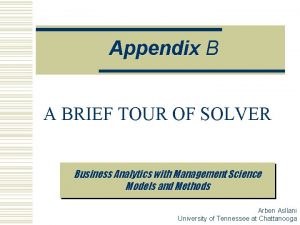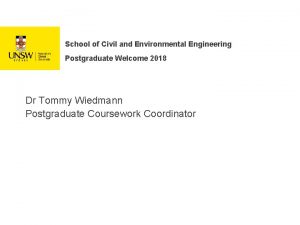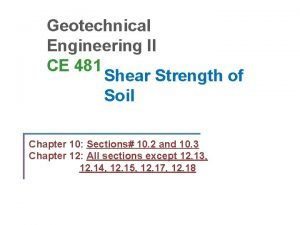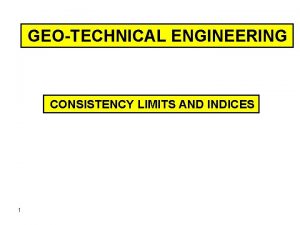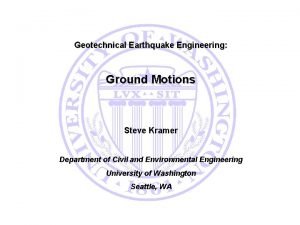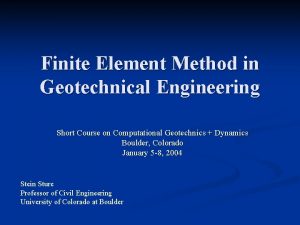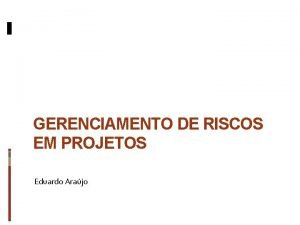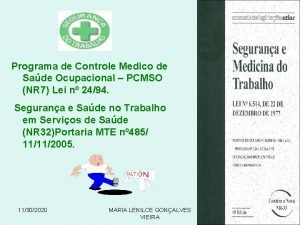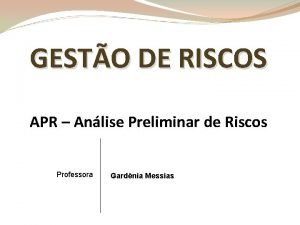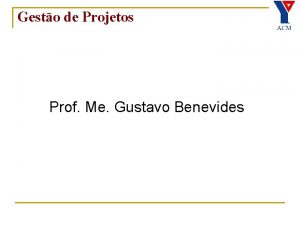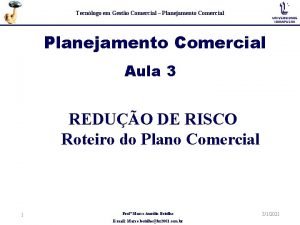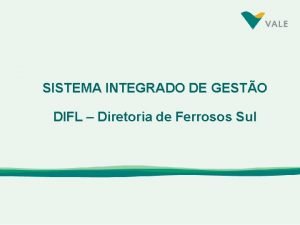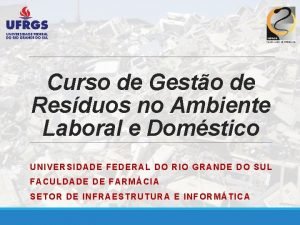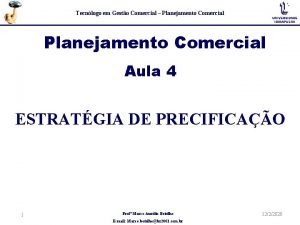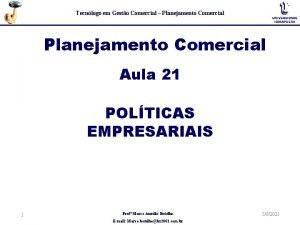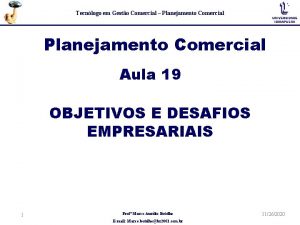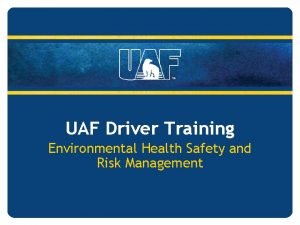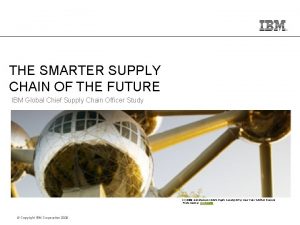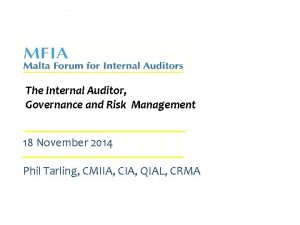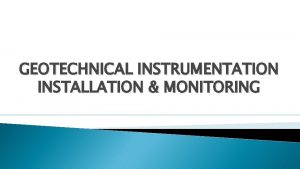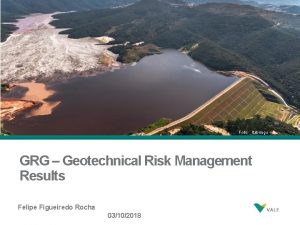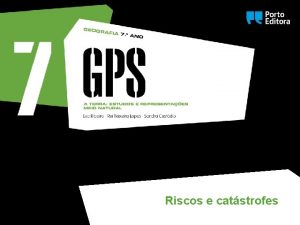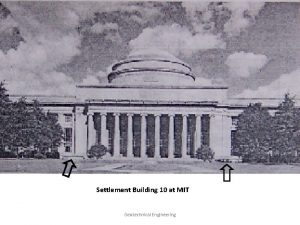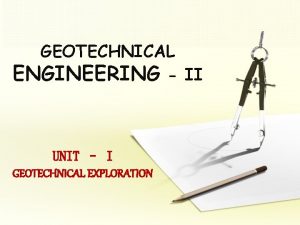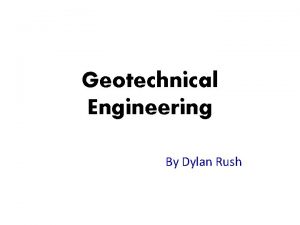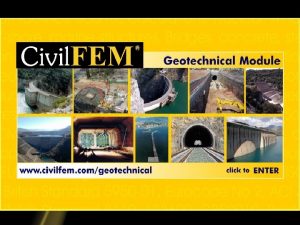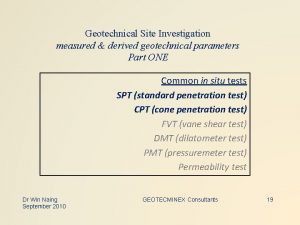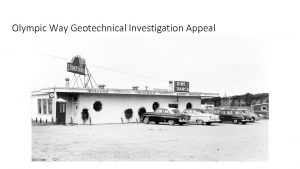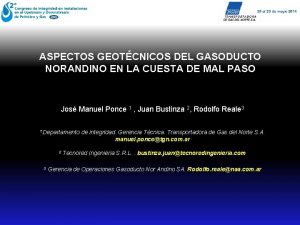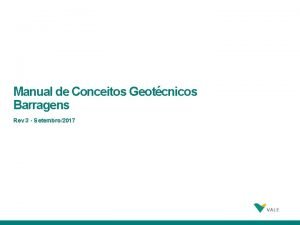GRG Gesto de Riscos Geotcnicos Geotechnical Risk Management


































































- Slides: 66

GRG – Gestão de Riscos Geotécnicos (Geotechnical Risk Management) Stability and Liquefaction Review Barragem I – Feijão Mine 1 16/11/17

0 - Summary 1 – Location 2 – Aerial View 3 – Status of Risk Analysis Studies – Dam I 4 – Dam I – Time Line 5 – Main Field and Laboratory Investigation 6 –Investigation – Main Results 7 – Past Stability Analysis 8 – Instrumentation 9 – GRG – Methodology for Deterministic Analysis – Drained Condition 10 – GRG – Methodology for Deterministic Liquefaction Analysis 11 – Some Aspects – Liquefaction Analysis 12 – Seismic Analysis 2

1 – Location 3

2 – Aerial View – june/2014 • • • 4 Function: Tailings facility Maximum height: 87 m; Crest length: 700 m Stored volume: 12. 7 Mm³ Status: No operation to tailing disposal

3 – STATUS OF RISK ANALYSIS STUDIES – DAM I • CONSOLIDATION REPORT - FINALIZED IN OCTOBER/2017 • DETERMINISTIC ANALYSIS (SCHEDULED TO NOVEMBER/2017) • PROBABILISTIC ANALYSIS (SCHEDULED TO DECEMBER/2017) 5

4 – DAM I - Time Line 1 - Initial Dam 18 m 1976 6 1977 1978 1979 1980 1981 1982 1983 1984 1985

4 – DAM I - Time Line 3 - Upstream Raising 1 - Initial Dam 18 m 1976 5 m 2 - Upstream Raising 3 m 1977 1978 1979 1980 1981 1982 1983 1984 Projet decision Event: Seepage Face – Initial Dam 7 1985

4 – DAM I - Time Line 3 - Upstream Raising 1 - Initial Dam 18 m 1976 5 m 2 - Upstream Raising 4 - Center line Raising 3 m 1977 1978 1979 1980 5 m (Covered Initial Dam and all upstream raising) 1981 1982 1983 1984 Event: Seepage Face – Initial Dam 8 1985

4 – DAM I - Time Line 6 - Upstream Raising 3 m 5 - Upstream Raising 5 m 1986 9 1987 1988 1989 1990 1991 1992 1993 1994 1995

4 – DAM I - Time Line 8 - Upstream Raising 4 m 6 - Upstream Raising 3 m 5 - Upstream Raising 7 - Upstream Raising 5 m 1986 3 m 1987 1988 1989 1990 1991 1992 1993 1994 Design Event: Seepage Face – Study Initial Dam, raising? (There. FS<1, 3 isn’t clear historical information) 10 1995

4 – DAM I - Time Line 8 - Upstream Raising 4 m 6 - Upstream Raising 3 m 5 - Upstream Raising 7 - Upstream Raising 5 m 1986 9 - Upstream Raising 6 m (Axis moved upstream) 3 m 1987 1988 1989 1990 1991 1992 1993 1994 Design Event: Seepage Face – Study Initial Dam, raising? (There. FS<1, 3 isn’t clear historical information) 11 1995

4 – DAM I - Time Line 11 - Upstream Raising 13 - Upstream Raising 6, 5 m 7 m 12 - Upstream Raising 10 - Upstream Raising 6, 5 m 5 m 1996 12 1997 1998 1999 2000 2001 2002 2003 2004 2005

4 – DAM I - Time Line 11 - Upstream Raising 13 - Upstream Raising 6, 5 m 7 m 12 - Upstream Raising 10 - Upstream Raising 6, 5 m 5 m 1996 1997 1998 1999 2000 Key year 2005 Design Studies Operational Rules New spillway on the right abutment Beach length control 13 2001 2002 2003 2004 2005 Event: Porepressure Elevation

4 – DAM I - Time Line 14 – Upstream Raising 15 - Upstream Raising 7, 5 m 2005 14 2006 2007 2008 5 m 2009 2010 2011 2012 2013 2014

4 – DAM I - Time Line End of tailing disposal – June/16 2015 2016 2017 Pumping the pond Note: seepage face occurred during all operation life. Reverse filter were performed by the operation team. 15

4 – DAM I – Time Line – Important aspects Tailing disposal without operational rules (1976 -2005) – EL. 929, 5 m (superficial spillway on right abutment) Setback axis 43 m Sinter Feed used in drainage system, until El. 922, 5 m 16 High piezometric levels No historical information, mainly about internal drainage system

5 – Main Field and Laboratory Investigations • CPTU, VANE TEST, SPT and LAB TESTS – 2005 • CPTU, VANE TEST and LAB TESTS – 2016 17

5. 1 – Field Investigation (2005) Dam Situation – Crest EL. 929, 5 m 08 CPTU 05 Vane Test 18

5. 1 – Field Investigation (2005) Dam Situation – Crest EL. 929, 5 m 29 SPT 25 Disturbed samples (beach) 19

5. 2 – Field Investigation (2016) Dam Situation – Crest EL. 942, 0 m 06 CPTU 04 undisturbed samples 20 09 Auger boring

5. 2 – Additional Field Investigation (2016) Dam Situation – Crest EL. 942, 0 m 03 CPTU 03 Vane Test 21

6 – Investigation – Main Results • CPTU, VANE TEST, SPT and LAB TEST – 2005 • CPTU, VANE TEST and LAB TEST – 2016 22

6. 1 – Field Tests (2005) Silva 23 (2010)

6. 1 – Field Tests (2005) - CPTU Silva (2010) 24

6. 1 – Field Tests (2005) - SPT Silva (2010) 25

6. 2 – Laboratory Tests (2016) 26

6. 2 – Laboratory Tests (2016) Test error? ? Very high Results!! 27

6. 2 – Laboratory Tests (2016) Representative? 28 Geoconsultoria (2016, 2017) Very high Results!!

6. 3 – Field Tests (2016) 29 Geoconsultoria (2016, 2017)

6. 3 – Field and Laboratory Tests (2016) Su/σ’v = 0, 36 (weighted average – 2/3 field test and 1/3 laboratory test) Assumed for liquefaction studies (2016/2017) Lower Boundary Upper Boundary 30 Geoconsultoria (2016, 2017)

7 – Past Stability Analysis • Drained Conditions – Geoconsultoria (2006) 31

7 – Past Stability Analysis • Undrained Conditions – Silva (2010) CPT results 32

7 – Past Stability Analysis • Undrained Conditions – Silva (2010) SPT results 33

7 – Past Stability Analysis • Undrained Conditions – Geoconsultoria (2016) 34

7 – Past Stability Analysis • Undrained Conditions – Geoconsultoria (2016) Stability Analysis Su/σvo Peak – Static 35

8 – Instrumentation (07 sections) • 93 Piezometers • 37 Water Level Indicator • 7 Bench Mark • 53 Flowmeter points • 02 Inclinometer (data not available) 36

8. 1 – Section 2 -2 – Instrumentation levels (August/2017) 37

8. 2 – Instrumentation – Monitoring Data End of tailing disposal – June/16 Location – Berm EL 809, 0 m Location – Berm EL 904, 0 m Level variation after disposal end is small (0, 30 to 0, 80 m) 38 End of tailing disposal – June/16

9 – GRG – Methodology for Deterministic Stability Analysis - Drained Condition • Modeling: the critical section for geological-geotechnical, piezometric and height conditions. • Piezometric Levels: August, 2017. • Strength Parameters: • Foundation: drained. • Soil Embankments: drained. • Tailings: drained. • The analysis were conducted with Software Slope/W, version 8, 16. 2. 14053, developed by Geo. Studio International LTDA. 39

9 – GRG –Deterministic Stability Analysis Drained Condition • Model and Piezometric Line SECTION 2 -2 40

9 – GRG –Deterministic Stability Analysis Drained Condition SECTION 2 -2 41

10 – GRG – Methodology for Deterministic Liquefaction Analysis • Modeling: the critical section for geological-geotechnical, piezometric and height conditions. • Piezometric Levels: August, 2017. • Strength Parameters: • Foundation: drained. • Soil Embankments: drained. • Tailings: undrained (contractive material below water level) and drained (dilative material or material above water level). • The analysis were conducted with Software Slope/W, version 8, 16. 2. 14053, developed by Geo. Studio International LTDA. • Methodology: Olson (2003) - yield and liquefied strength. 42

10 – GRG – Deterministic Liquefaction Analysis • Model and Piezometric Line SECTION 2 -2 43

10 – GRG –Deterministic Liquefaction Analysis Yield Strength SECTION 2 -2 44

10 – Deterministic Liquefaction Analysis – Liquefied Strength 45 SECTION 2 -2

11 – Some Aspects – Liquefaction Analysis 11. 1 - Methodologies to analyse liquefaction: POULOS ET AL 1985 – Based on laboratory tests (require good sampling and many laboratory testing); SEED AND HARDER 1990 – Based on correction factors; OLSON 2001 – Based on backanalysis of historical liquefaction flow failures to evaluate Su yield and Su liquefied. – Susceptibitily – Triggering – Post-triggering 46

11 – Some Aspects – Liquefaction Analysis 11. 2 - How to define liquefaction susceptibility? Original Recommendation 47

11 – Some Aspects – Liquefaction Analysis Effect of material compressibility * CSL is roughly parallel to NCL for very loose sands 48

11 – Some Aspects – Liquefaction Analysis * Update - to define susceptibility – Correct the boundary 49

11 – Some Aspects – Liquefaction Analysis 12. 3 - How to define yield shear strength and liquefied shear strength to use in the studies? What data was avaliable? o. Basic informations about tailings (Atterberg Limits, grains size analysis, solid unit weight, emax, emin) o. SPT – 29 tests (2005) o. CPTu – 8 tests (2005) and 9 tests (2016) o. Vane tests – 5 tests (2005) and 3 tests (2016) o. Triaxial tests – (4 pits – one block/pit) - 50 1 CK 0 U test – undisturbed sample -2016 4 CU tests – undisturbed sample - 2016 8 CU tests – remolded sample - 2016

11 – Some Aspects – Liquefaction Analysis What data was used in past studies? o Silva (2010) Correlations - Su(yield)/ σv 0 x qc 1 (CPT) and Su(yield)/ σv 0 x (N 1)60 (SPT) from Olson, 2001. Su(yield)/ σv 0 x qc 1 - range - 0, 235 - 0, 282 Su(yield)/ σv 0 x (N 1)60 - range - 0, 238 - 0, 267 51

11 – Some Aspects – Liquefaction Analysis o Geoconsultoria (2016) Observation 1 – How much undrained are the vane tests results? (Average remolded triaxial tests) 52

11 – Some Aspects – Liquefaction Analysis Observation 2 – the results of the triaxial tests are greater than bibliography values Remolded samples results 53

11 – Some Aspects – Liquefaction Analysis Observation 2 – the results of the triaxial tests are greater than bibliography values 54

11 – Some Aspects – Liquefaction Analysis Discussion about the Lab Tests on remolded samples What affect yield shear strenghts? Were compactation degrees 79% and 83% (remolded samples) representative? 55

11 – Some Aspects – Liquefaction Analysis Discussion about the Lab Tests on remolded samples What affect yield shear strenghts? K in situ versus k in lab test 56

11 – Some Aspects – Liquefaction Analysis Discussion about the Lab Tests on remolded samples What affect yield shear strenghts? Impact of mode of shear 57

11 – Some Aspects – Liquefaction Analysis Discussion about the Lab Tests on remolded samples 1 - What affect yield shear strenghts? 58

11 – Some Aspects – Liquefaction Analysis Discussion about the Lab Tests on remolded samples Some observations about remolded tests (79% and 83% compaction degree) Observation 1 – Dilative response in many tests CIU PI 04 Remolded 83% G. C. 59

11 – Some Aspects – Liquefaction Analysis Discussion about the Lab Tests on remolded samples Some observations about remolded tests (79% and 83% compaction degree) Observation 2 – Negative deviator stress for 50 k. Pa test 60 CIU PI 01 Remolded 79% G. C.

11 – Some Aspects – Liquefaction Analysis Discussion about the Lab Tests on remolded samples Some observations about remolded tests (79% and 83% compaction degree) Observation 3 – Deviator stress at the test spread sheet is diferent from the sumary graphic 61

62

11 – Some Aspects – Liquefaction Analysis Discussion about the Lab Tests on remolded samples Some observations about remolded tests (79% and 83% compaction degree) Observation 4 – There are few data to reasonably estimate the liquefied strengh ratios 63

11 – Some Aspects – Liquefaction Analysis Conclusions • There is a considerable dispersion in laboratory tests results; • Many problems had been found in laboratory tests results; • The triaxial tests results showed yield strength ratio much larger than bibliography data; • There is no enough results for liquefied strength ratio in laboratory tests. 64

11 – Some Aspects – Liquefaction Analysis Conclusions • For Geotechnical Risk Management studies that are in development, it was strongly suggested to use only CPTu tests to estimate yield strength ratio and liquefied strength ratio. Su/σ’v 65

12 – Seismic Analysis Pseudo-static stability analysis carried out for Dam I took into account the accelerations proposed by the ELETROBRAS manual (2003). (ELETROBRÁS, 2003) H=0, 05 g V=0, 03 g There isn´t a local seismicity study provided by VALE at Feijão Mine. Relatively small-magnitude earthquakes could trigger liquefaction of the tailings. It is extremely important to develop specific seismicity studies to support the pseudostatic analysis and liquefaction failure mode studies. 66
 Grg nonlinear solver
Grg nonlinear solver Grg otomotiv aksaray
Grg otomotiv aksaray Geotechnical data management
Geotechnical data management Geotechnical data management
Geotechnical data management Liquidity measures
Liquidity measures Unsw geotechnical engineering masters
Unsw geotechnical engineering masters Applied geotechnical engineering
Applied geotechnical engineering Consolidated drained triaxial test example
Consolidated drained triaxial test example Consistency limits in geotechnical engineering
Consistency limits in geotechnical engineering Geotechnical engineering
Geotechnical engineering Geotechnical earthquake engineering kramer
Geotechnical earthquake engineering kramer Finite element method in geotechnical engineering
Finite element method in geotechnical engineering Master of construction management swinburne
Master of construction management swinburne Riscos ocupacionais
Riscos ocupacionais Inventário de risco
Inventário de risco Risco de entalamento
Risco de entalamento Plano de escavação nr 18
Plano de escavação nr 18 Grupo de riscos
Grupo de riscos Riscos puros
Riscos puros Riscos ergonomicos enfermagem
Riscos ergonomicos enfermagem Mapa de riscos ambientais
Mapa de riscos ambientais Gesto patografo
Gesto patografo Derivados de gesto
Derivados de gesto Gesto gustavo
Gesto gustavo Protoimperativos y protodeclarativos
Protoimperativos y protodeclarativos Filastrocca del piccolo gesto importante
Filastrocca del piccolo gesto importante Proxemica
Proxemica Gesto comercial
Gesto comercial Gesto comercial
Gesto comercial Gesto comercial
Gesto comercial Sistema gesto
Sistema gesto Www.cross.saude.sp.gov.br/principal.php
Www.cross.saude.sp.gov.br/principal.php Gesto comercial
Gesto comercial Gesto laboral
Gesto laboral Gesto comercial
Gesto comercial Gesto comercial
Gesto comercial Gesto comercial
Gesto comercial Asseponto funcionário
Asseponto funcionário Gesto comercial
Gesto comercial Gesto cultural
Gesto cultural Key risk indicators financial risk management
Key risk indicators financial risk management Risk map risk management
Risk map risk management What is risk projection in software engineering
What is risk projection in software engineering Risk avoidance insurance
Risk avoidance insurance How to calculate relative risk
How to calculate relative risk Residual risk and secondary risk pmp
Residual risk and secondary risk pmp Inherent risks examples
Inherent risks examples Absolute risk vs relative risk
Absolute risk vs relative risk Smg stock split
Smg stock split Classification of risk
Classification of risk Pembelanjaan risiko adalah
Pembelanjaan risiko adalah The biggest risk is not taking any risk
The biggest risk is not taking any risk Business risk vs audit risk
Business risk vs audit risk Business vs financial risk
Business vs financial risk Attributable risk formula
Attributable risk formula Relative risk and attributable risk
Relative risk and attributable risk Pyramid levels of management
Pyramid levels of management Management pyramid
Management pyramid Top level management
Top level management Wvu risk management
Wvu risk management Cook county risk management
Cook county risk management Uaf risk management
Uaf risk management Wharton risk management program
Wharton risk management program Cal state
Cal state Ibm supply chain strategy
Ibm supply chain strategy Data governance and risk management
Data governance and risk management Combining internal audit and risk management
Combining internal audit and risk management
